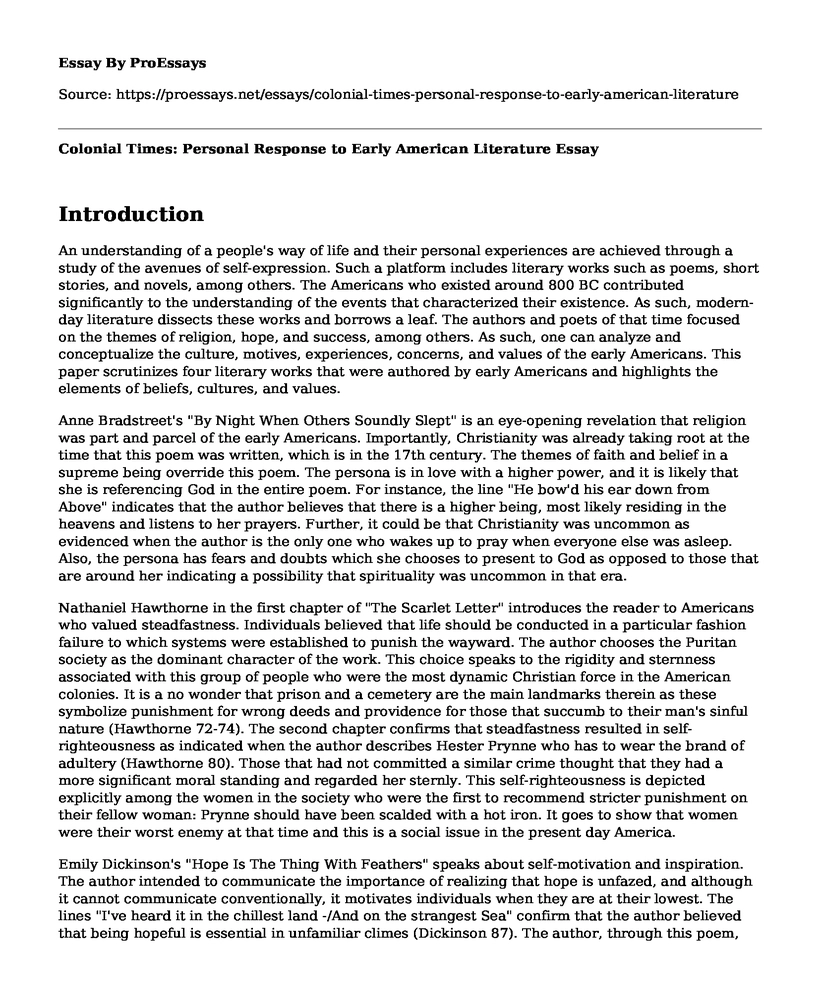Introduction
An understanding of a people's way of life and their personal experiences are achieved through a study of the avenues of self-expression. Such a platform includes literary works such as poems, short stories, and novels, among others. The Americans who existed around 800 BC contributed significantly to the understanding of the events that characterized their existence. As such, modern-day literature dissects these works and borrows a leaf. The authors and poets of that time focused on the themes of religion, hope, and success, among others. As such, one can analyze and conceptualize the culture, motives, experiences, concerns, and values of the early Americans. This paper scrutinizes four literary works that were authored by early Americans and highlights the elements of beliefs, cultures, and values.
Anne Bradstreet's "By Night When Others Soundly Slept" is an eye-opening revelation that religion was part and parcel of the early Americans. Importantly, Christianity was already taking root at the time that this poem was written, which is in the 17th century. The themes of faith and belief in a supreme being override this poem. The persona is in love with a higher power, and it is likely that she is referencing God in the entire poem. For instance, the line "He bow'd his ear down from Above" indicates that the author believes that there is a higher being, most likely residing in the heavens and listens to her prayers. Further, it could be that Christianity was uncommon as evidenced when the author is the only one who wakes up to pray when everyone else was asleep. Also, the persona has fears and doubts which she chooses to present to God as opposed to those that are around her indicating a possibility that spirituality was uncommon in that era.
Nathaniel Hawthorne in the first chapter of "The Scarlet Letter" introduces the reader to Americans who valued steadfastness. Individuals believed that life should be conducted in a particular fashion failure to which systems were established to punish the wayward. The author chooses the Puritan society as the dominant character of the work. This choice speaks to the rigidity and sternness associated with this group of people who were the most dynamic Christian force in the American colonies. It is a no wonder that prison and a cemetery are the main landmarks therein as these symbolize punishment for wrong deeds and providence for those that succumb to their man's sinful nature (Hawthorne 72-74). The second chapter confirms that steadfastness resulted in self-righteousness as indicated when the author describes Hester Prynne who has to wear the brand of adultery (Hawthorne 80). Those that had not committed a similar crime thought that they had a more significant moral standing and regarded her sternly. This self-righteousness is depicted explicitly among the women in the society who were the first to recommend stricter punishment on their fellow woman: Prynne should have been scalded with a hot iron. It goes to show that women were their worst enemy at that time and this is a social issue in the present day America.
Emily Dickinson's "Hope Is The Thing With Feathers" speaks about self-motivation and inspiration. The author intended to communicate the importance of realizing that hope is unfazed, and although it cannot communicate conventionally, it motivates individuals when they are at their lowest. The lines "I've heard it in the chillest land -/And on the strangest Sea" confirm that the author believed that being hopeful is essential in unfamiliar climes (Dickinson 87). The author, through this poem, narrates the source of her resilience in troubled times. She could have been expressing her personal experience as a recluse who relied on hope to overcome various challenges such as her lack of adventure.
In another poem titled "Success Is Counted Sweetest" Emily Dickinson communicates her concerns about the truths of human desires. The poem specifically talks about the desire for success and opines that those who fail to appreciate the gravity of success. The use of military imagery communicates that this era was marked with wars hence the familiarity with military troops as evidenced by the line "Not one of all the purple Host" (Dickinson 7). Further, this analogy, coupled with the tone of the poem, reveals that the narrator is detached from the element of success. The author is but a reporter meaning that she most likely falls into the category of those that have not experienced success. At the same time, the author implies that the early Americans were deprived of victory hence they valued and craved it.
Conclusion
Finally, "Success Is Counted Sweetest" has an element of feminism as evidenced by the use of the words nectar and sweet in the first stanza. Dickinson was of the opinion that women were deprived of the rights that were accorded to their male counterparts. The early American culture intended to enslave women and treat them as inferior to men. As such, she goes to show that the agony that men experience when they fail is not only an indication of vulnerability but also a unifying factor since both parties have their weaknesses.
Works Cited
Dickinson, Emily. Poems. ReadHowYouWant. com, 2008.
Hawthorne, Nathaniel, and Cindy Weinstein. The scarlet letter. Oxford University Press, 2008.
Cite this page
Colonial Times: Personal Response to Early American Literature. (2022, Apr 20). Retrieved from https://proessays.net/essays/colonial-times-personal-response-to-early-american-literature
If you are the original author of this essay and no longer wish to have it published on the ProEssays website, please click below to request its removal:
- History of Aesthetic Styles - Essay Example
- Essay Example: Is Okonkwo a Tragic Hero?
- The House on Mango Street by Sandra Cisneros: The Immigrant Woman Essay
- Poetry Analysis Essay on "Diving into the Wreck" by Adrienne Rich
- The Picture of Dorian Gray Novel Analysis Paper Example
- Myths, Supernatural Powers, and Cultural Parallels: Ancient Sumerians and Greeks - Essay Sample
- Essay Example on August Wilson: American Playwright and Chronicler of African American Struggles







